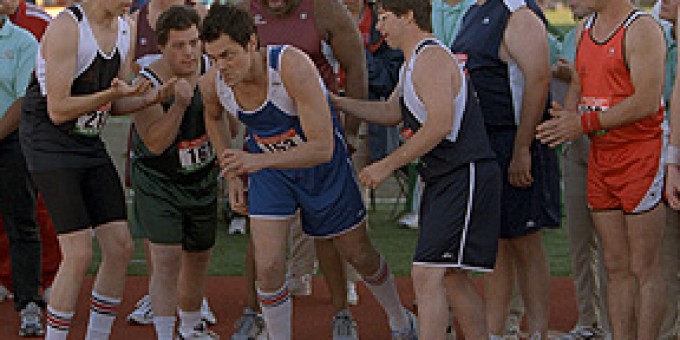
In 2008, the release of the action-comedy film Tropic Thunder, written, produced, and directed by Ben Stiller, brought forth condemnation from more than a dozen disability advocacy groups, including the Special Olympics and the National Down Syndrome Congress. The plot entails a film within a film—a group of struggling actors making a movie set in the Vietnam War. Stiller plays the role of Tugg Speedman, an actor who portrays “Simple Jack” in the war movie they’re making. Simple Jack is a mentally challenged character who is repeatedly called a “retard” by his co-stars. Although film critics acknowledged this element of the film as offensive, they generally gave it positive reviews.
Retard, of course, is a term that has come into disrepute because of its derogatory use as a metaphor that demeans both the specific person and all people with intellectual disabilities (the term that has now replaced mental retardation, itself once considered an improvement over such words as imbecile, idiot, and moron). More generally, retard is part of the language that is used, sometimes intentionally and sometimes unintentionally, in ways that characterize what disability advocates and scholars call “ableism,” a system of oppression comparable to racism, sexism, and heterosexism that subjects people with disabilities to social degradation and institutional discrimination.
In his critique of Tropic Thunder, Timothy Shriver of the Special Olympics went so far as to dub use of the term retard “hate speech.” Stiller, in turn, said the critics had missed the point. The film, he tried to explain, was an “edgy” satire of actors who use people (and characters) with disabilities as fodder for acclaim. The joke, added co-writer Ethan Cohen, is really on people like Dustin Hoffman (“Rain Man”), Tom Hanks (“Forrest Gump”), and Sean Penn (“I Am Sam”). Shriver found this defense unpersuasive, telling an interviewer on National Public Radio that the derogation and social exclusion of people with intellectual disabilities “stems from the attitude that most [nondisabled] people feel they’re worthless, that they don’t have value, that they can’t contribute. This word [retard] has come to mean all those things. It’s not any longer funny to perpetuate that stigma.”From a disability advocacy perspective, however, the question remains as to whether humor on the subject of disability should be off-limits. In this regard, disability studies scholars Kim Reid, Edy Hammond Stoughton, and Robin Smith make an important distinction between “disabling humor” and “disability humor,” the former referring to humor that denigrates and the latter to humor that enlightens. It is essentially the difference between laughing at them and laughing with them. This view considers whether nondisabled characters or ableist attitudes and practices are ever positioned as the source of humor in situations with disabled characters.
Indeed, disability as a comedic trope goes back to the slapstick days of the silent film era, and it has been a staple of the film industry ever since. Today there are even a number of stand-up comedians with disabilities who capitalize on their insider perspective to poke fun at ableism and use humor to slip positive images of disability into mainstream culture.
Themes in Disability Films
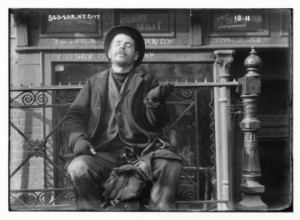
According to film historian Martin Norden, a common theme in the slapstick comedies of the silent film era was the “disability scam artist,” an able-bodied character impersonating a disabled person. In Blind Man’s Bluff (1903), for example, a purportedly blind, one-legged beggar, seeing that a passerby has given him a bogus coin, strikes the passerby with his wooden leg. Some observers of the day thought making fun of the physically disabled was acceptable only if the characters were not really disabled, but, as a cultural notion, this theme had adverse consequences for beggars who were truly disabled. In New York City in 1896, for instance, Police Chief Peter Conlin justified the crackdown on beggars with disabilities as a way to get the sham ones off the streets—but he made no distinction between those who were disabled and those who were not.
Another theme that emerged in the silent film era was the “comic misadventurer,” a disabled character who gets into trouble because of his or her impairment. In The Invalid’s Adventure (1907), a wheelchair user escapes from his attendant and initiates a wild chase that entails a number of ludicrous accidents in which the “invalid” manages to maintain his balance. Similarly, W.C. Fields’s It’s a Gift (1934), a talking remake of his silent It’s the Old Army Game (1926), includes a superfluous scene in which an elderly visually- and hearing-impaired woman makes a mess in a grocery store. Two decades later, the comic misadventurer appeared in the form of the animated Mr. Magoo, a visually-impaired character featuring the voice of Jim Backus. First introduced as a theatrical short in 1949, then in the first feature length film in 1959 and a live action comedy starring Leslie Nielsen in 1997, Mr. Magoo was even the star of a cartoon TV series that aired in the 1960s and ‘70s.
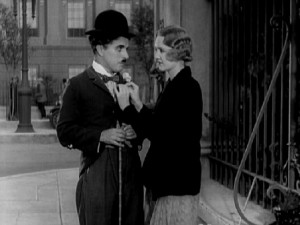
Charlie Chaplin, the preeminent comedian of the silent film era, also employed disability themes as a counterpoint to his famous Tramp character, a comic misadventurer in his own right. In City Lights (1931), one of Chaplin’s best remembered pictures, the Tramp sets his mind on winning the heart of a beautiful blind flower-seller, who represents the “sweet innocent” theme in disability filmmaking (characteristic of dramatic representations of disability, as well). By happenstance, the young woman thinks the Tramp is wealthy, and when he learns that her sight can be restored by an operation she cannot afford, he goes about finding the money to help her. Throughout the film the woman remains nameless, and she’s only referred to in the credits as “A blind girl.” The part was played by Virginia Cherrill, and Chaplin remarked that one of his goals in casting her “was to find a girl who could look blind without detracting from her beauty.”
Just as Chaplin combined comedy with the sweet innocent theme, in Dr. Strangelove or: How I Learned to Stop Worrying and Love the Bomb (1964), director Stanley Kubrick combined comedy and the “demonic cripple” theme. This genre of disability filmmaking goes back to the days of the first film based on Victor Hugo’s The Hunchback of Notre Dame, starring Lon Chaney in 1923. There is no doubt that Dr. Strangelove, as a sardonic comedy about the dangers of nuclear war, has many redeeming qualities, but the film’s depiction of the ridiculous but villainous Dr. Strangelove, played by Peter Sellers, troubles some disability advocates. In the film, Dr. Strangelove is a strategic military advisor to the President of the United States, but he is also depicted as an ex-Nazi who has never abandoned his devotion to the Führer. He uses a wheelchair and has a bionic hand covered by a leather glove, prone to malfunction as it attempts to raise the “Heil Hitler” salute and, at times, to strangle its owner’s neck.
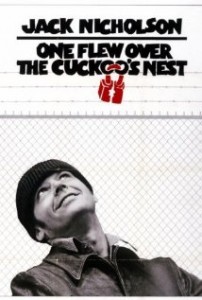 This anti-disability representation can be contrasted with that in One Flew Over the Cuckoo’s Nest (1975), a film that is arguably more trenchant from a pro-disability perspective. Based on the Ken Kesey novel, Cuckoo’s Nest tells the story of Randle McMurphy, a rebellious criminal serving a short sentence for statutory rape. When McMurphy (played by Jack Nicholson) is transferred to a mental institution for evaluation, he hopes to stay there to avoid going back to prison. Unlike the other films I have mentioned, Cuckoo’s Nest offers a satirical critique of societal practices by portraying the mental institution, with its mind-numbing daily routines and unpleasant medical treatments, as a major source of the residents’ grief; in particular, it paints the staff, especially the hard-nosed, inflexible, and even sadistic nurse Mildred Ratched, as even more “crazy” than the residents. The film also brings to mind psychologist D. L. Rosenhan’s study “Being Sane in Insane Places,” a field experiment in which eight pseudopatients faked symptoms of mental illness to gain admission to a mental hospital; when they reverted to “normal behavior,” the staff still treated all eight as if they were ill.
This anti-disability representation can be contrasted with that in One Flew Over the Cuckoo’s Nest (1975), a film that is arguably more trenchant from a pro-disability perspective. Based on the Ken Kesey novel, Cuckoo’s Nest tells the story of Randle McMurphy, a rebellious criminal serving a short sentence for statutory rape. When McMurphy (played by Jack Nicholson) is transferred to a mental institution for evaluation, he hopes to stay there to avoid going back to prison. Unlike the other films I have mentioned, Cuckoo’s Nest offers a satirical critique of societal practices by portraying the mental institution, with its mind-numbing daily routines and unpleasant medical treatments, as a major source of the residents’ grief; in particular, it paints the staff, especially the hard-nosed, inflexible, and even sadistic nurse Mildred Ratched, as even more “crazy” than the residents. The film also brings to mind psychologist D. L. Rosenhan’s study “Being Sane in Insane Places,” a field experiment in which eight pseudopatients faked symptoms of mental illness to gain admission to a mental hospital; when they reverted to “normal behavior,” the staff still treated all eight as if they were ill.
Mental disability is also the subject of Being There (1979), another film starring Peter Sellers. In this turn, Sellers plays Chance, a simple-minded gardener. Chance has the intellectual capacity of a child, and he has lived a totally dependent and isolated life. All he knows of the world is what he sees on TV. For reasons unexplained, Chance has been living with a wealthy benefactor, and when the benefactor dies, he is forced to leave his home for the first time. After wandering around the city for a while, he is struck by a car owned by a wealthy businessman. This happenstance leads Chance into the world of the superrich and their high-powered associates—including the President of the United States—who are eager for sagely wisdom and think that Chance’s observations about gardening are metaphorical, really offering incisive advice about business and politics. This storyline is characteristic of yet another theme in disability filmmaking: the “wise simpleton.” In some sense, this is a variant of the sweet innocent, but it also critiques the intellectual shallowness and pretentiousness of elite society. Fifteen years later, the portrait of an intellectually disabled man as a wise simpleton was the subject of Forrest Gump (1994), in which Tom Hanks plays a naïve man who witnesses, and in some cases influences, some of the defining events of the latter half of the twentieth century.
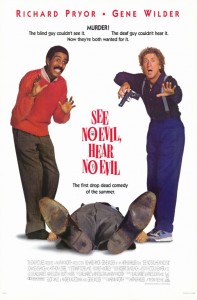 Two 1980s films starring Richard Pryor, Bustin’ Loose (1981) and See No Evil, Hear No Evil (1989), the latter with Gene Wilder, regretfully show that sensitivity to the oppression of one group of people does not easily translate into sensitivity to the oppression of another group. Pryor, whose stand-up routines offered biting commentary on race relations in the United States, could do nothing more in these films than regurgitate the comic misadventurer theme. In Bustin’ Loose, Pryor plays an ex-convict responsible for guiding a busload of physically and cognitively disabled youths through an assortment of misadventures including the almost obligatory scene for comedies with blind characters: driving a motor vehicle. In See No Evil, Hear No Evil, Pryor and Wilder play two disabled men, one visually impaired and one hearing impaired, who enact an unending series of slapstick gags that make fun of the characters’ disabilities.
Two 1980s films starring Richard Pryor, Bustin’ Loose (1981) and See No Evil, Hear No Evil (1989), the latter with Gene Wilder, regretfully show that sensitivity to the oppression of one group of people does not easily translate into sensitivity to the oppression of another group. Pryor, whose stand-up routines offered biting commentary on race relations in the United States, could do nothing more in these films than regurgitate the comic misadventurer theme. In Bustin’ Loose, Pryor plays an ex-convict responsible for guiding a busload of physically and cognitively disabled youths through an assortment of misadventures including the almost obligatory scene for comedies with blind characters: driving a motor vehicle. In See No Evil, Hear No Evil, Pryor and Wilder play two disabled men, one visually impaired and one hearing impaired, who enact an unending series of slapstick gags that make fun of the characters’ disabilities.
The Farrelly Brothers
Throughout the 1990s and 2000s, no comedic directors were as preoccupied with disability themes as Peter and Bobby Farrelly. In an analysis of five of the films they directed between 1994 and 2003, disability studies scholar Kathleen LeBesco characterizes their contribution to the disability genre as a mixed bag: some entail the standard fare of making fun of disabled characters, while some actually function to challenge ableist assumptions about people with disabilities.
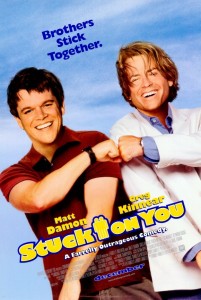 LeBesco is rather critical of Dumb and Dumber (1994), the first of these films, because the treatment of “a pair of dim-witted friends” is at the expense of disabled people and lacks “none of the humanity that infuses” their disabled characters in later films such as Stuck on You (2003), a story about two conjoined twins. What LeBesco finds appealing about Stuck on You is that its storyline portrays social stigma and discrimination, not the characters’ impairment, as the cause of their problems. In fact, she suggests the film portrays the conjoined brothers as “able to function more effectively in a number of areas (sports, food preparation, trick or treating) than any of us singletons do, and… their main difficulty comes in encountering cruel and close minded people.” LeBesco also appreciates the fact that the cast includes “a relatively large number of disabled people. Actors using wheelchairs, actors with intellectual or developmental disabilities, actors with congenital variations—all seem to find a place here, whether as extras in a crowd scene, as featured extras, or as important minor characters.” In this way, she argues, Stuck on You counters the all-too-often societal expectation that people with disabilities, in real life, should be cloistered and concealed.
LeBesco is rather critical of Dumb and Dumber (1994), the first of these films, because the treatment of “a pair of dim-witted friends” is at the expense of disabled people and lacks “none of the humanity that infuses” their disabled characters in later films such as Stuck on You (2003), a story about two conjoined twins. What LeBesco finds appealing about Stuck on You is that its storyline portrays social stigma and discrimination, not the characters’ impairment, as the cause of their problems. In fact, she suggests the film portrays the conjoined brothers as “able to function more effectively in a number of areas (sports, food preparation, trick or treating) than any of us singletons do, and… their main difficulty comes in encountering cruel and close minded people.” LeBesco also appreciates the fact that the cast includes “a relatively large number of disabled people. Actors using wheelchairs, actors with intellectual or developmental disabilities, actors with congenital variations—all seem to find a place here, whether as extras in a crowd scene, as featured extras, or as important minor characters.” In this way, she argues, Stuck on You counters the all-too-often societal expectation that people with disabilities, in real life, should be cloistered and concealed.
What LeBesco also likes about Me, Myself and Irene (2000) and Shallow Hal (2001), films about a schizophrenic and a very obese woman, respectively, is their use of nondisabled people’s “treatment of disabled people as the barometers by which they can be morally evaluated.” She finds it noteworthy, however, that the Farrelly films that did the best at the box office—Dumb and Dumber and There’s Something about Mary (1998)—do no such thing. In the latter film, people with disabilities are made the butt of the joke—we are laughing at them, not with them. For example, Mary has a brother, Warren, who has an emotional disability that causes him to react violently at the slightest touch of his ear. In another scenario, Ted, one of Mary’s suitors, bends over backwards moving heavy furniture for a grouchy and unappreciative disabled man, whose wheelchair bumper sticker reads, “How’s my driving? Call 1-800-eat-shit.” Healy, another of Mary’s suitors, tries to impress her by lying about working with people with intellectual disabilities. “My passion is my hobby,” he says. “I work with retards.” In this scene it is interesting to observe the film’s self-consciousness about “political incorrectness,” although it does so in a way that trivializes the issue. When Mary calls Healy on his use of the term “retards,” Healy replies, confounded, “To hell with that—no one’s gonna tell me who I can and can’t work with.”
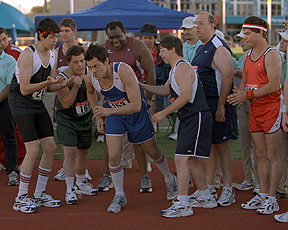
Like some of their previous films, the Farrellys’ The Ringer (2005), which they produced but did not direct, has brought mixed reaction from the disability community. The lead character Steve Barker, played by Johnny Knoxville, reincarnates the disability scam artist storyline by faking a mental disability so he can enter the Special Olympics and win a gambling bet. Barker proceeds to amuse the audience by practicing his impersonations of “retarded” stereotypes (where we are supposed to laugh at, not with, disabled people). Upon entering the competition, he meets the other participants, most of whom are played by actors who actually have the disabilities they display. In another example of the wise simpleton theme, these characters come across, according to reviewer Eric Snider, as “savvy, quick-witted, …full of insightful wisdom.” To the plot’s credit, Barker ultimately realizes the error of his ways and we’re “told in no uncertain terms that mocking the handicapped is wrong.” Reviewer James Charney finds it commendable that The Ringer makes an attempt to question ableist assumptions, but notes that it’s telling that it didn’t do as well at the box office as the Farrelly films that more consistently pandered to the public’s inclination to disparage people with disabilities. The humor of comedians with disabilities shows us another way.
Comedians with Disabilities
In making a distinction between disabling humor and disabled humor, Reid and colleagues believe it is disabled people themselves who are best positioned to employ affirming rather than derisive humor about disability. Geri Jewell, an actor who has cerebral palsy, was a path breaker in this regard, appearing in a dozen episodes of the popular sitcom Facts of Life from 1980 to 1984. According to Disaboom blogger Lawrence Carter Long, just as the sitcoms Ellen and Will and Grace “paved the way for greater acceptance of gays and lesbians years later, Jewell’s affable” character increased viewers’ comfort level with people with disabilities.In 1994 Jewell was featured in a Public Television documentary about “stand-up” disability comedians, Look Who’s Laughing. Other comics in the documentary included Kathy Buckley (who is deaf), Chris Fonseca (who has cerebral palsy), Alex Valdez (who is blind), J. D. England (who has paraplegia), and Bret Leake (who has multiple sclerosis).
Long notes that one element in some of their routines is the use of “self-deprecating humor to shatter stereotypes and preconceived notions about people with disabilities.” By making jokes like these, adds Tim O’Connor in a review in Disability Studies Quarterly, the comics demonstrate that disabled people “are not so fragile as to need constant condescension through mock sentiments of political correctness.” Buckley, for instance, tells a joke about not having dates because she is flat-chested and too tall… but then she considers whether she may have fewer dates because she “didn’t hear the phone ring.” Fonseca, who speaks in a slow, methodical cadence, plays on stereotypical attitudes when he jokes, “I’m handicapped and I’m Mexican, so you know what that means: If you piss me off, I’m gonna pull a knife and we’re both gonna get hurt.” In another bit, he capitalizes on his unsteady arm movements by recounting his experience at a shooting gallery at a state fair: “Last year I won a teddy bear… Ok, I didn’t win it. They gave it to me so I would put down the rifle… It works every time.” Josh Blue, a comic and Paralympian with cerebral palsy who won the TV competition Last Comic Standing in 2006, tells a similar joke when he describes the effectiveness of the “palsy punch” in a fight: “First of all, they don’t know where the punch is coming from, and second of all, neither do I!”
Some nondisabled comedians competing for stage time at comedy clubs think that disabled comedians have an advantage because they have a “gimmick.” But it’s really the audience that renders judgment about these comics, not on the basis of their disability, but on the basis of whether they are truly funny. As one night-club owner observes, “A [disabled] guy has a gimmick for two minutes, after that he has to win the audience on his own merits. A gimmick doesn’t mean a thing. He has to have substance and quality.”
Comedy is a dialogic cultural practice that relies on symbolic patterns of meaning that enable audiences to “get” the joke. Disabling humor works because of ableist prejudices that are embedded in the collective conscience. But philosopher Warren Shibles argues that humor based on the degradation of a group of people is not really humor at all. For lack of a better term, Shriver calls it hate speech. Disability humor, on the other hand, has the potential to undermine the assumptions and institutional practices upon which disabling humor is based, while also attenuating nondisabled people’s discomfort with disability issues and allowing for empathic understanding of matters that are difficult to acknowledge or express in other contexts. That is, when it comes to changing societal expectations of disability, humor can be transformative.
Recommended Reading
Beth Haller. 2010. Representing Disability in an Ableist World: Essays on Mass Media. A consideration of contemporary media representation in the news, television, and film.
Kathleen LeBesco. 2004. “There’s Something about Disability: The Contradictions of Freakery in the Films of the Farrelly Brothers.” Disability Studies Quarterly. A critical review of the Farrelly brothers’ films.
Martin F. Norden. 1994. The Cinema of Isolation: A History of Physical Disability in the Movies. A comprehensive historical review of disability in films from the silent era to the early 1990s.
D. Kim Reid, Edy Hammond Toughton, and Robin M. Smith. 2006. “The Humorous Construction of Disability: ‘Stand-Up’ Comedians in the United States.” Disability & Society. Uses the distinction between disabling humor and disability humor to interpret the humor of comedians with disabilities.
Kara Shultz and Darla Germeroth. 1998. “Should We Laugh or Should We Cry? John Callahan’s Humor as a Tool to Change Societal Attitudes toward Disability.” Howard Journal of Communication. An analysis of the work of a gag cartoonist known for his biting humor and irreverence toward political correctness.

Comments 3
Charles S. Green, III — December 31, 2012
One thing Ron doesn't mention here is the films of comedian Jerry Lewis,particularly the ones he made in the 50s and 60s. Two of my high school classmates had parents with multiple sclerosis and a third classmate had muscular dystrophy. All three felt uncomfortable with Lewis's movies because they felt his slapstick humor, with its spasms and pratfalls, were mocking people with disabilities.
Does anyone else have the same misgivings about those films?
Ron Berger — January 1, 2013
Tuck (Charles) makes a good point about Jerry Lewis. Disability activists have also been critical of his muscular dystrophy telethon, which features pitiable “poster children” who help raise money for a preventative cure, but does little to improve the lives of those who are already disabled. Under Lewis’s tutelage, the Muscular Dystrophy Association even positioned itself as having a philosophy that was in contradistinction to the Americans with Disabilities Act, and while dedicating himself to the agenda of preventing muscular dystrophy, he has become known for his disparaging comments about people with disabilities. During the 1973 telethon, for example, Lewis said, “God goofed, and it’s up to us to correct His mistakes.”
Protests against Lewis galvanized in the early 1990s after he called people with disabilities “half persons” in a Parade magazine article. In the early 2000s, when Lewis was asked about the protests during a CBS Sunday Morning broadcast, he said, “Pity? You don’t want to be pitied for being a cripple in a wheelchair? Stay in your house.” Along the way, Lewis also used anti-gay slurs during the telethons, raising the ire of other groups. As fewer and fewer TV stations began carrying the telethon, and when they did, showing it late at night, Lewis became increasingly disgruntled, and the more disability activists pushed back against him, the more outrageous things he said.
Dick — May 13, 2016
It's interesting that professional entertainers paid literally millions of dollars a year to joke about subjects that are strictly off limits for members of the general public.